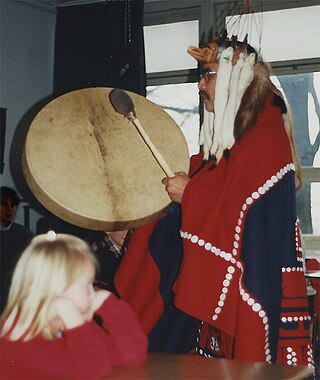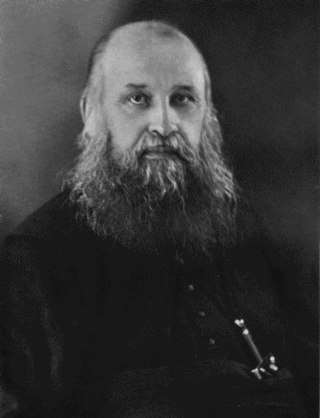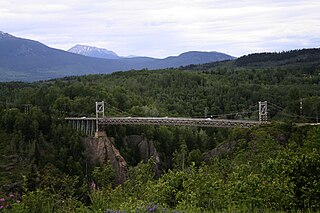
The Tsimshian are an Indigenous people of the Pacific Northwest Coast of North America. Their communities are mostly in coastal British Columbia in Terrace and Prince Rupert, and Metlakatla, Alaska on Annette Island, the only reservation in Alaska.

The Dakelh or Carrier are the indigenous people of a large portion of the Central Interior of British Columbia, Canada. Another name the Dakelh/Carrier call themselves is Yinka Dene, the Babine-Witsuwitʼen-speaking bands prefer the equivalent Yinka Whut'en.

Hazelton is a village municipality in the Skeena region of west central British Columbia, Canada. The place is on the southeast side of the Skeena River immediately north of the Bulkley River mouth, where the confluence forms a peninsula. On BC Highway 62, the locality is by road about 75 kilometres (47 mi) northwest of Smithers and 144 kilometres (89 mi) northeast of Terrace. Hazelton is the original of the "Three Hazeltons", the other two being New Hazelton to the southeast and South Hazelton to the south.

The Skeena River is the second-longest river entirely within British Columbia, Canada. Since ancient times, the Skeena has been an important transportation artery, particularly for the Tsimshian and the Gitxsan—whose names mean "inside the River of Mist" ,and "people of the River of Mist," respectively. The river and its basin sustain a wide variety of fish, wildlife, and vegetation, and communities native to the area depend on the health of the river. The Tsimshian migrated to the Lower Skeena River, and the Gitxsan occupy territory of the Upper Skeena.

The Bulkley River in British Columbia is a major tributary of the Skeena River. The Bulkley is 257 kilometres (160 mi) long with a drainage basin covering 12,400 square kilometres (4,800 sq mi).

The Wetʼsuwetʼen are a First Nation who live on the Bulkley River and around Burns Lake, Broman Lake, and François Lake in the northwestern Central Interior of British Columbia.

Houston is a forestry, mining and tourism town in the Bulkley Valley of the Northern Interior of British Columbia, Canada. Its population as of 2021 was 3,052, with approximately 2,000 in the surrounding rural area. It is known as the "steelhead capital" and it has the world's largest fly fishing rod. Houston's tourism industry is largely based on ecotourism and Steelhead Park, situated along Highway 16. Houston is named in honour of the pioneer newspaperman John Houston.

The Wetʼsuwetʼen First Nation is a Wetʼsuwetʼen First Nations band located outside of the village of Burns Lake, British Columbia, Canada. It was formerly known as the Broman Lake Indian Band and is still usually referred to as Broman Lake although this is no longer its official name. Its members speak the Wetʼsuwetʼen dialect of Babine-Witsuwitʼen, a Northern Athabaskan language. The main community is on Palling Indian Reserve No. 1.

The Bulkley Valley is in the northwest Central Interior of British Columbia, Canada.

Adrien-Gabriel Morice was a missionary priest belonging to the Oblates of Mary Immaculate. He served as a missionary in Canada, and created a writing system for the Carrier language.

Gitxsan are an Indigenous people in Canada whose home territory comprises most of the area known as the Skeena Country in English. Gitksan territory encompasses approximately 35,000 km2 (14,000 sq mi) of land, from the basin of the upper Skeena River from about Legate Creek to the Skeena's headwaters and its surrounding tributaries. Part of the Tsimshianic language group, their culture is considered to be part of the civilization of the Indigenous peoples of the Pacific Northwest Coast, although their territory lies in the Interior rather than on the Coast. They were at one time also known as the Interior Tsimshian, a term which also included the Nisga'a, the Gitxsan's neighbours to the north. Their neighbours to the west are the Tsimshian while to the east the Wetʼsuwetʼen, an Athapaskan people, with whom they have a long and deep relationship and shared political and cultural community.

The Witset First Nation is a First Nations band government of the Wet'suwet'en people of Witset, British Columbia, Canada. Their mailing address is in Smithers, but their main community is at Witset.

Kispiox is a Gitxsan village of approximately 550 in the Kispiox Valley, at the confluence of the Kispiox and Skeena Rivers in British Columbia. Located 13 km (8 mi) north of Hazelton, the community is situated within the Kispiox Indian reserve and is managed by the Kispiox Band Council.
New Hazelton is a district municipality on the south side of the Bulkley River in the Skeena region of west central British Columbia, Canada. On BC Highway 16, the locality is by road about 68 kilometres (42 mi) northwest of Smithers and 137 kilometres (85 mi) northeast of Terrace. New Hazelton is one of the "Three Hazeltons", the other two being the original "Old" Hazelton to the northwest and South Hazelton to the west.
Hagwilget Canyon is a canyon on the Bulkley River of northwestern British Columbia, Canada, located several kilometres upstream from that river's confluence with the Skeena River at Hazelton, at the Wet'suwet'en village of Hagwilget.
Glen Vowell is an Indian reserve community of the Gitxsan people in the Hazelton area of the Skeena Country of northwestern British Columbia, Canada. It is located on the west side of the Skeena River between Hazelton and Kispiox. Its traditional name is Sik i dak, which has also been spelled Sikadoak and is reflected in the name of the reserve, Sik-e-dakh IR 2. Also nearby is another Indian reserve, Anlaw Indian Reserve No. 4. The band government of the reserve is the Glen Vowell Indian Band, which also goes by the name Sik-e-Dakh.
Hagwilget or Hagwilgyet is a First Nations reserve community of the Gitxsan people located on the lower Bulkley River just east of Hazelton in northwestern British Columbia, Canada. The community's name means "well-dressed" as in "ostentatious," though another meaning is "the quiet people". It has also been spelled Awillgate and Ackwilgate and it has also been named Rocher Déboulé - "falling rock" - a reference to a landslide in this area from Rocher Déboulé Mountain, which blocked salmon runs on the Bulkley River at this location.

Hagwilget Canyon Bridge is a suspension bridge over the Hagwilget Canyon on the Bulkley River, at the Wet'suwet'en village of Hagwilget, British Columbia. The current bridge was constructed in 1931, and later reinforced in 1990.

The Unistʼotʼen Camp is a protest camp and indigenous healing centre in northern British Columbia, Canada. It is located within the traditional territory of the Unist'otʼen clan of the Wetʼsuwetʼen First Nation peoples. Established after the proposal of several pipeline projects in the area, it is situated where several pipelines will pass, as a means to block their construction.















